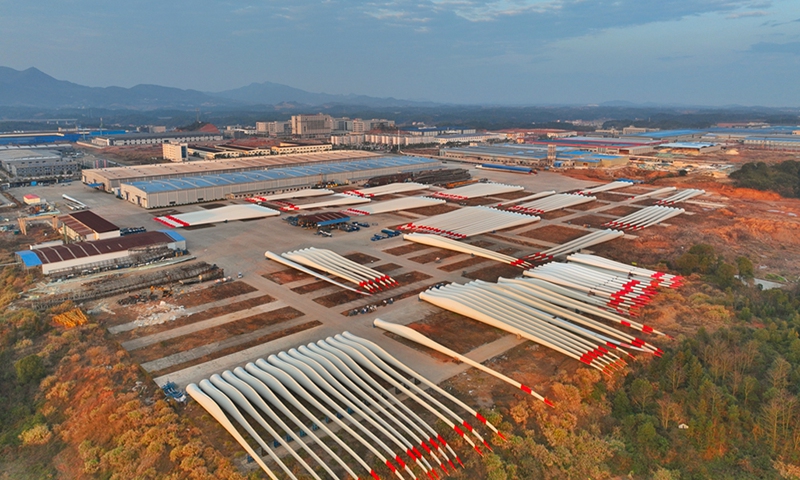
This aerial photo taken on January 14, 2024 shows wind turbine blades prepared for shipment in Pingxiang, East China's Jiangxi Province. Photo: VCG
Despite the challenges posed by the lackluster global economy and an increasingly complex, severe, and uncertain external environment, China's economy managed to achieve 5.2 percent growth in 2023. This growth contributed over 30 percent to global economic growth, solidifying China's role as a crucial engine for global economic expansion. China's economy, which is pushing over risks and challenges, has maintained steady growth in terms of quantity and scale.
In the face of multiple challenges, China successfully exceeded its annual growth target of around 5 percent set by the Government Work Report for 2023, further enhancing its status as one of the world's top economies. In comparison with other major economies, China's growth outpaced the 2.5 percent of the US, the 0.5 percent of the EU, and the 1.9 percent of Japan.
Economic development should not only be assessed based on quantity, but also on the quality of structural improvements. China's high-tech industries are at the forefront of driving economic growth. In 2023, investment in technological transformation of manufacturing increased by 3.8 percent compared with the previous year, leading to a rise in the proportion of high-tech manufacturing to 15.7 percent and equipment manufacturing to 33.6 percent in the value-added industrial output.
The integration of digital technology and the real economy is solidly advancing, with e-commerce transaction volume increasing by 9.4 percent compared with the previous year, and the value added of information transmission, software and information technology services growing by 11.9 percent.
The high-tech exports are driving overall export growth. In 2023, China's total goods exports stood at 23.77 trillion yuan ($3.29 trillion), an increase of 0.6 percent, while the combined exports of "new three items" - electric vehicles, lithium-ion batteries, and solar cells reached 1.06 trillion yuan, an increase of 29.9 percent year-on-year.
China has maintained the fastest growth in the world ten or twenty years ago. The world has been accustomed to China's fast growth, thinking that only fast growth is natural for China. However, it should be recognized that the Chinese economy has long surpassed the threshold of 100 trillion yuan, which is the sum of Germany, Japan, India, the UK, and Italy. Entering a new stage of high-level and high-quality development, for the 100 trillion yuan-level Chinese economy, simply observing growth rate is one-sided and biased.
Currently, the giant ship of China's economy needs to cruise at a steady pace. Its growth rate, whether too fast or too slow, is not conducive to high-quality economic development. Issues such as insufficient consumption momentum, debt risks in the real estate sector, and hidden debts at the local level still exist.
Meanwhile, the continuous deepening of urbanization, breakthroughs in technological innovation, healthy development of the private economy, and innovative changes in digital economy and artificial intelligence are all positive factors for the long-term improvement of China's economy.
Overall, the favorable conditions for China's development are stronger than the unfavorable factors. The basic trend of economic recovery and improvement will not change over the long term, combined with the confidence and determination for China's development which will remain into the future. In the current transition from old to new driving forces, stability is particularly important.
Although the current global situation is constantly changing and factors that are not conducive to globalization and economic growth are increasing, China still insists on new levels of development. This has always been China's commitment to the world's development.
Many observers around the world are looking for an economy that could replace China's crucial role. Indeed, countries like India, Vietnam, and Mexico are actively seizing the opportunities emerging from the adjustment in the global industrial supply chain. However, China has already built a strong foundation in the industrial supply chain for the global industrial leap, technological breakthroughs, and the development of emerging industries. Supported by the massive infrastructure network built since China's reform and opening-up, China's comprehensive cost advantage is irreplaceable.
China is actively exploring in the fields of technological innovation, development of private economy, and cultivation of new quality productive forces, which will stimulate the vitality and momentum of China's development. The Chinese economy is in a period of steady recovery and key structural adjustment. With ample potential for continued growth, the economy is not "peaking" as Western media hyped.
To observe China's economic growth and high-quality development, one needs to look at it with a developmental perspective. China is a super large single market, and urbanization is still in progress. China has a complete industrial chain and supply chain system, and has crossed the critical point of mid-term industrialization development. Looking across the world, there are hardly any other major countries that simultaneously meet these features. In this sense, for a considerable period of time in the future, China's crucial role in the world economy will not be replaced.
As part of a new round of globalization, China is actively attracting foreign investment, while Chinese companies are also accelerating their pace of expanding globally.
On the one hand, a large amount of foreign investment in scientific research is accelerating into China, utilizing Chinese human capital to promote the development of world technology. China is also continuously optimizing the business and investment environment, creating opportunities for companies around the world.
On the other hand, Chinese companies are ramping up their expansion efforts by taking manufacturing, the digital economy, cross-border e-commerce, and digital trade to a global scale. This strategic move is opening up new opportunities for China in the current wave of globalization.
The author is the assistant president of the China Development Institute and the director of the Digital Strategy and Economic Research Center. bizopinion@globaltimes.com.cn

